In the world of manufacturing, various techniques are employed to transform raw materials into finished products. Among these techniques, one that stands out due to its precision, versatility, and cost-effectiveness is metal stamping. This process is used across a multitude of industries, from automotive and aerospace to construction, medical, and electronics, and plays a pivotal role in creating high-quality products that we use daily.
In this comprehensive guide, we will delve into the ins and outs of metal stamping, covering its types, the equipment used, the design processes, and more. Whether you’re a professional in the field, a curious engineering student, or someone who simply wants to understand the underpinnings of everyday products, this guide will provide you with everything you need to know about metal stamping.

The Basics of Metal Stamping
Metal stamping is a manufacturing process that uses dies and stamping presses to transform flat sheet metal into specific shapes. It is a complex process that includes a range of metal forming techniques such as punching, blanking, embossing, bending, flanging, and coining.
The foundation of metal stamping lies in the precise application of pressure on the metal sheet, which is placed in a die that has the negative of the desired shape. A stamping press, which is a specially designed machine tool, applies a high-pressure downward force onto the metal, causing it to form into the specific shape outlined in the die.
Advatages of metal stamping
A key advantage of metal stamping is its versatility. By using customized dies, manufacturers can create a wide array of intricate designs and shapes. This manufacturing technique is capable of producing high volumes of consistent, high-quality metal parts efficiently. Moreover, metal stamping can be used with a variety of metals, including steel, aluminum, copper, brass, bronze, and stainless steel, making it a flexible solution for many industrial applications.
Disadvantages of metal stamping
While metal stamping is a cost-effective production method for large quantities, the initial tooling costs can be relatively high due to the design and creation of specific stamping dies. Nevertheless, when spread over large production volumes, the cost per unit becomes remarkably low.
How does Metal stamping work?
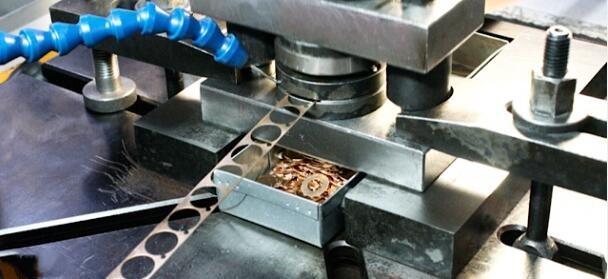
The metal stamping process begins with a flat sheet of metal, commonly referred to as a ‘blank’. This blank is placed into the stamping press, where the die and punch are located. The punch is a component of the stamping press that moves downward and forces the metal into the die, creating the desired shape.
Step 1: Material Preparation
The metal stamping process begins with material preparation. A flat sheet or coil of metal, often referred to as a blank, is selected based on the requirements of the part being produced. The material can vary in thickness, size, and type, depending on the specific application.
Step 2: Tool and Die Design
Once the material is prepared, the next step involves designing the tooling, including the dies and punches. The dies consist of a female die (containing a cavity) and a male punch (matching the cavity shape). The tool and die design is crucial as it determines the final shape and features of the stamped part.
Step 3: Setup and Alignment
In this step, the blank is fed into the stamping press, and the tooling is aligned to ensure precise positioning of the blank. Proper alignment is essential for consistent and accurate stamping throughout the production process.
Step 4: Stamping Operations
With the setup complete, the stamping process begins. The press applies force to the blank, forcing it into the cavity of the die. The metal deforms and takes the shape of the die, forming the desired features and contours of the part. The press stroke can be a single operation or a series of operations, depending on the complexity of the part.
Step 5: Secondary Operations
After the initial stamping operation, additional secondary operations may be performed to refine the part or add specific features. These operations can include bending, coining, embossing, piercing, or trimming.
Types of Metal Stamping
Once we have a firm understanding of the basics of metal stamping, we can delve into the different types of stamping processes. The type of stamping chosen largely depends on the complexity of the part, production volume, and the specific requirements of the project.
Progressive Stamping

In progressive stamping, a continuous metal strip is fed into the stamping press, which moves the strip through a series of stations. Each station in the press performs a specific operation on the metal strip, gradually transforming it into the final part shape. These stations can include operations such as piercing, blanking, bending, drawing, coining, or forming.
The strip is advanced by the press between each operation, allowing for sequential operations to be performed in a continuous manner. As the strip progresses through the press, the part undergoes a gradual transformation, with each station adding a specific feature or forming operation.
It is commonly used to manufacture components such as brackets, clips, connectors, terminals, electrical contacts, and intricate metal parts with precise tolerances.
Deep Draw Stamping
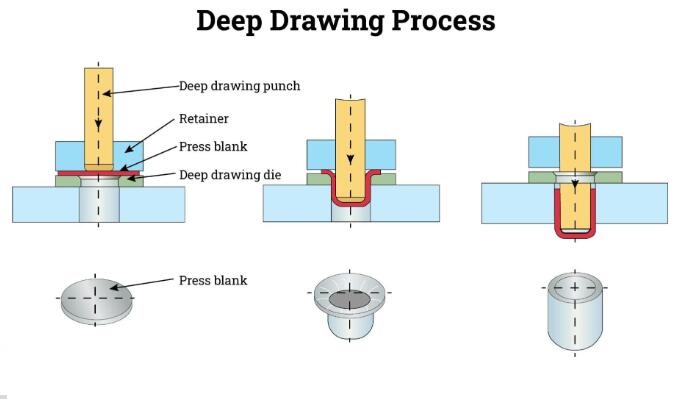
Deep draw stamping is a specialized metal stamping process used to create cylindrical or box-shaped parts with significant depth. It allows for the production of seamless, hollow components that have a higher depth-to-diameter ratio compared to other stamping techniques.
The working process is as below:
Blanking: A flat metal sheet is cut from a larger coil or sheet material to create a blank of the required size and shape.
Placing and Clamping: The blank is placed onto a draw ring, which holds it firmly in place during the deep draw stamping process. The draw ring prevents the blank from wrinkling or buckling during the forming operations.
Drawing: The punch descends and pushes the metal blank into the cavity of the die, causing it to deform and take on the shape of the die. The material is stretched and thinned as it is drawn deeper into the die cavity.
Redrawing: In some cases, the process may involve multiple redraw operations to achieve the desired depth and shape. This is done by transferring the partially formed part to another set of dies for further shaping and redrawing.
Trimming: After the deep draw stamping process, excess material is trimmed off from the formed part to achieve the final shape and dimensions.
This process is commonly used to create parts like cans, tanks, sinks, and anything that requires depth and roundness.
Fourslide Stamping
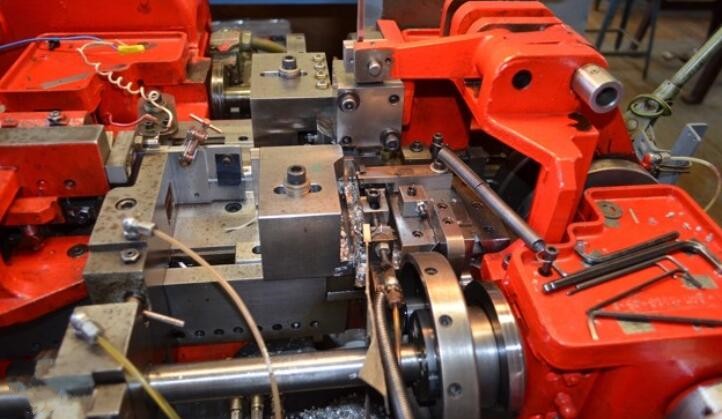
Fourslide stamping, also known as multislide stamping or four-way stamping, involves a horizontal alignment of four sliding tools.Fourslide stamping utilizes a multislide machine equipped with multiple slides that move horizontally and vertically. Each slide carries various tools, including punches, forming tools, and cutoff tools. As the metal strip is fed into the machine, the slides work in synchronization to perform multiple operations simultaneously.
It’s an ideal process for creating complex components, such as wire forms or springs, with multiple bends or twists.
Fineblanking
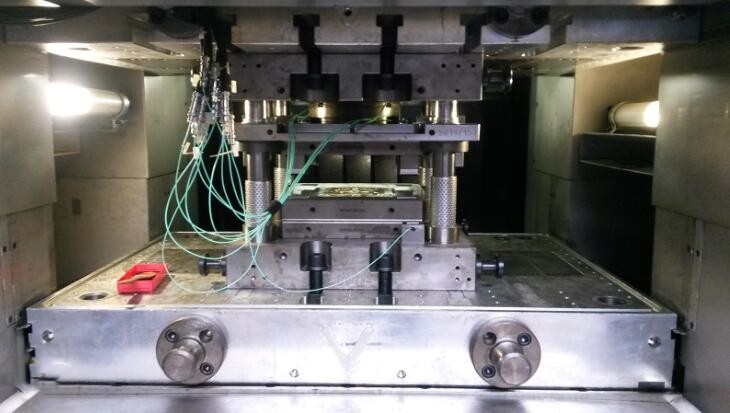
Fineblanking is a precision metal forming process used when higher accuracy and smooth edges are required.
Fineblanking is an advanced metal stamping process used to produce precision parts with tight dimensional tolerances and superior edge quality.
Fineblanking is a specialized form of blanking that combines stamping, shearing, and extrusion operations. It involves the use of a fineblanking press, which consists of a punch, a die, and a counterpunch. The punch and counterpunch work together to hold the material while the die performs the cutting and extrusion operations.The process consists of the following steps:
Feeding: A metal strip is fed into the fineblanking press, positioning it between the punch and the die.
Initial Punching: The punch applies force to pierce a hole in the metal strip. Unlike traditional stamping, where the punch and die meet, in fineblanking, the punch is supported by a ring that surrounds it.
Reduction Shearing: After the initial punch, a secondary punch continues to apply force while the ring restrains the material around the punched hole. This results in a shearing action that cleanly separates the part from the surrounding material.
Coining and Forming: As the punch continues to press against the material, a third punch, known as the pressure pad, exerts counterforce to precisely control the part’s shape and form. This allows for the creation of intricate geometries and tight tolerances.
Ejection: Once the fineblanking operation is complete, the finished part is ejected from the press, while the remaining scrap material is removed.
It is often used in the automotive and tooling industries where precision is of utmost importance.
Types of Stamping Presses
Stamping presses are specialized machines that deliver the necessary force to stamp metals into specific shapes. They are a crucial element in the metal stamping process, with a variety of types available, each offering different capabilities depending on the requirements of the project.
Mechanical Presses
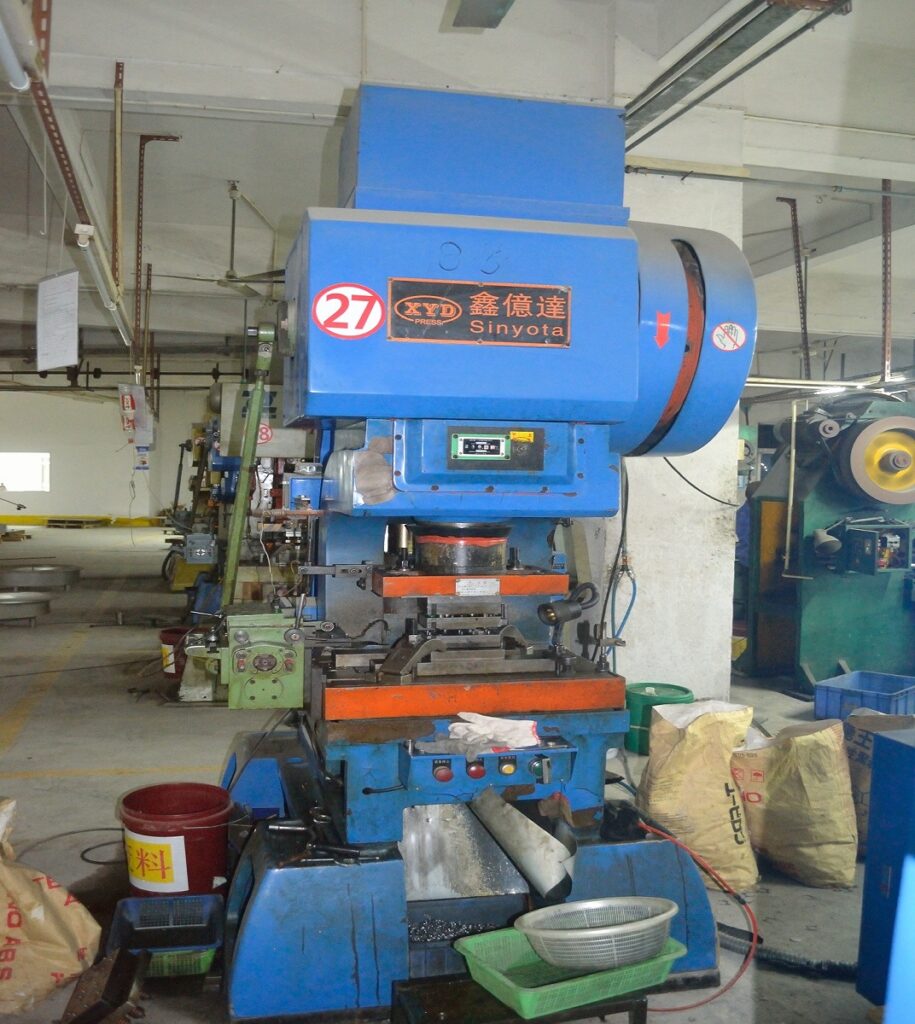
Mechanical presses function by converting rotational motion from a motor into linear motion. This process involves the use of a flywheel, clutch, and crankshaft. When the motor is activated, it drives the flywheel, storing energy within it. The clutch then engages, releasing the stored energy into the crankshaft, which in turn drives the ram to deliver a stamping action.
Mechanical presses come in a variety of sizes and capacities, typically rated by their maximum amount of force, measured in tons. The speed of these presses is measured in strokes per minute (SPM), and they can often reach high rates, making them ideal for high-volume production runs.
One of the advantages of mechanical presses is their high-speed operation and precision. The ram movement’s consistency provides uniformity in the parts produced, a crucial factor in many industries such as automotive and electronics. However, the stroke length and speed are not easily adjustable during operation, which could be a limitation when flexibility is required.
Mechanical presses are often used for blanking, piercing, forming, and drawing. Blanking is a process where the workpiece is cut from the primary metal sheet, while piercing creates holes in the workpiece. Forming alters the workpiece’s shape without removing any material, and drawing involves pulling a sheet metal into a die, producing a raised part.
Despite their advantages, mechanical presses also have certain limitations. They operate at a fixed speed, which may not be ideal for processes requiring varying speeds. Furthermore, the force they apply is highest at the bottom of the stroke, which can limit their effectiveness for certain applications.
On the safety front, while most mechanical presses come with built-in safety systems, improper use or lack of maintenance can potentially lead to accidents. These machines require regular inspection and maintenance to ensure safe and efficient operation.
Hydraulic Presses
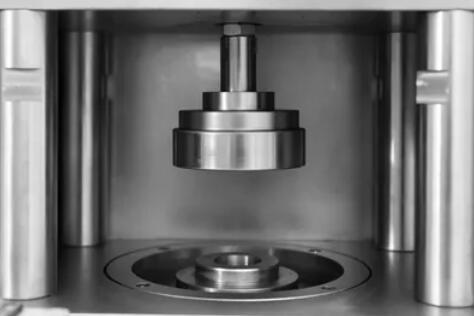
Hydraulic presses operate differently from mechanical presses. Instead of converting rotational motion into linear motion, these machines use hydraulic cylinders filled with hydraulic fluid (usually oil) to generate the force necessary for stamping. When the hydraulic pump is activated, it pushes the fluid into the cylinders, forcing the piston to move and thus driving the ram of the press.
One major advantage of hydraulic presses is the ability to deliver a large amount of force over a small area. This is due to the incompressibility of the hydraulic fluid, allowing for a strong and even distribution of pressure. It also enables the press to handle a wide range of materials and thicknesses, making it a versatile choice for applications such as deep draw stamping.
Hydraulic presses are also known for their controllability. Unlike mechanical presses, these machines allow for easy adjustment of force, speed, and stroke length during operation. This flexibility makes them suitable for complex and delicate stamping tasks. However, the speed of hydraulic presses is generally slower than that of mechanical presses, which can be a disadvantage in high-volume production settings.
Servo Presses
Servo presses utilize servomotors in the drive system, which results in highly precise, adjustable speed and position control. Unlike mechanical and hydraulic presses, the energy in a servo press is generated electrically, and the press force and position are controlled in real time by the servomotor. This allows for total control over the press stroke, leading to more versatility in the pressing process.
The advantages of servo presses include the flexibility of the stroke length and press speed, lower energy consumption compared to traditional presses, and improved productivity due to its ability to perform complex strokes and jobs that require precision. They are also quieter and have less vibration, leading to a better working environment.
Servo presses are ideal for jobs requiring a high degree of control and precision. They are used in a variety of applications, such as assembly, clinching, forming, and embossing. The use of a servo press can significantly improve the quality of the final product and enhance the efficiency of the metal stamping process.
Please note, just as in other types of presses, safety considerations should be at the forefront when operating a servo press. Proper training and adherence to safety protocols are necessary to prevent accidents and ensure a safe working environment.
Transfer Presses
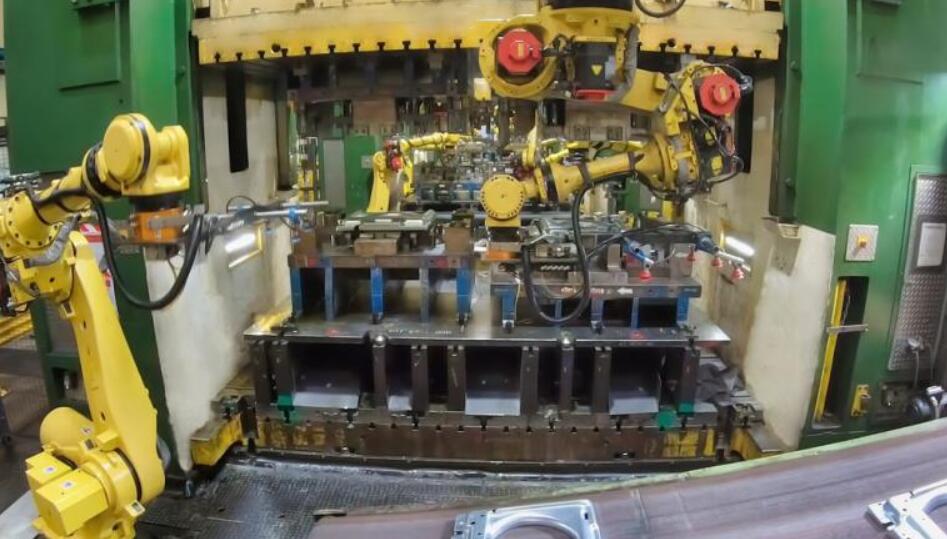
Transfer presses differ from other types of presses in that they are specifically designed to move the workpiece from one station to the next during the stamping process. This is accomplished through the use of mechanical ‘fingers’ or other types of material handling equipment.
This process is ideal for the production of complex parts that require multiple stamping operations, such as punching, bending, and deep drawing, to be performed in a specific sequence. The main advantage of transfer presses is that they can execute these different operations simultaneously, leading to higher productivity and efficiency.
Furthermore, transfer presses are highly flexible and can handle various materials and part sizes, making them suitable for a wide range of stamping applications. They are commonly used in the automotive industry for the production of complex and large components such as engine blocks and chassis.
A potential downside of transfer presses is the requirement for larger upfront investment and space compared to other types of presses due to their complexity and size. Nevertheless, the high output rate and versatility often justify this initial investment.
As with all types of metal stamping equipment, safety is a key concern when operating transfer presses. Operators should be thoroughly trained on the equipment and always follow safety protocols to prevent any potential accidents.
What are Stamping Dies?
In the metal stamping process, stamping dies play a vital role. A stamping die is a specialized tool consisting of two parts: the female die and the male punch. The female die is a cavity or recessed area, while the male punch is the component that fits into the die cavity.
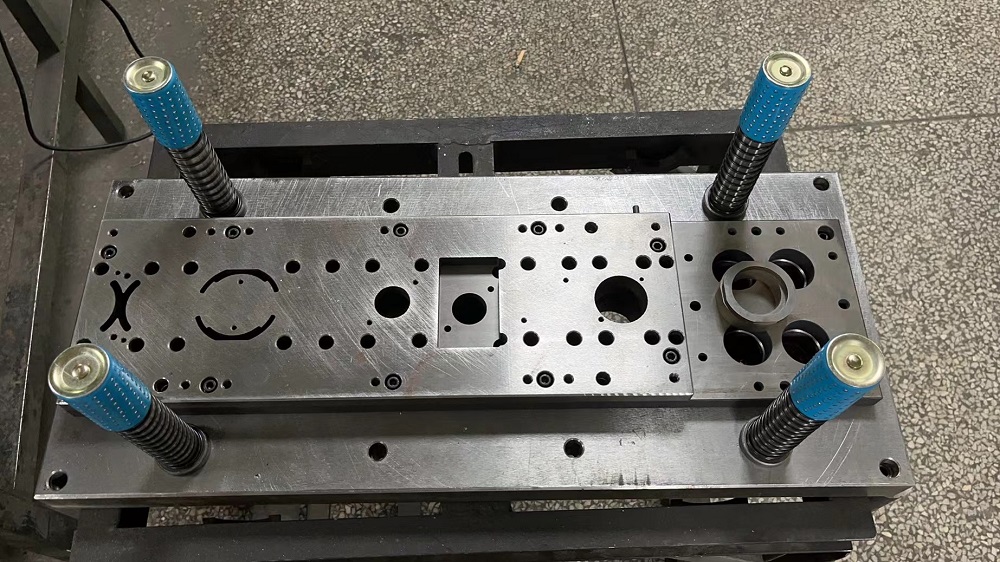
How They’re Used in the Stamping Process
Stamping dies are used to shape and cut the metal during the stamping process. When the metal sheet is placed between the female die and the male punch, pressure is applied by the stamping press, causing the metal to take the shape of the die cavity. The male punch exerts force on the metal sheet, allowing for various operations like piercing, blanking, bending, or forming to be performed.
Stamping dies are designed to precisely create the desired shape and dimensions of the final stamped part. They are typically custom-made to match the specific requirements of the project. The design process involves considering factors such as the material being stamped, the complexity of the part, and the required tolerances.
During the stamping process, the metal sheet is fed into the press, positioned accurately, and then the press applies the necessary force to drive the male punch into the female die. This action allows the metal to be deformed into the desired shape or cut into the required pattern.
The quality and precision of the stamping dies are critical to the overall success of the metal stamping process. Well-designed and well-maintained dies ensure consistent and accurate results, minimizing waste and increasing efficiency. Regular maintenance, inspection, and potential repairs or replacements are necessary to maintain the performance of the stamping dies over time.
Stamping dies can be categorized into various types, such as single-stage dies, compound dies, progressive dies, and transfer dies. Each type has its own specific characteristics and advantages, catering to different stamping requirements and complexities.
Wantto learn more about the die types, you could enjoy this page.
Metal Stamping Design Processes
The design processes in metal stamping are crucial for ensuring the successful production of high-quality stamped parts. These processes involve careful planning, analysis, and considerations of various factors to create effective and efficient stamping operations.
Design for Manufacturability (DFM)
Design for Manufacturability (DFM) is a critical step in metal stamping. It involves optimizing the part design to ensure that it can be easily and cost-effectively manufactured using the stamping process. During the DFM stage, the following factors are taken into account:
Material Selection: Choosing the appropriate material for the desired function and compatibility with the stamping process.
Part Geometry: Designing the part with suitable draft angles, radii, and fillets to facilitate easy forming and reduce the risk of cracking or tearing.
Tooling Considerations: Ensuring that the part design is compatible with the available stamping presses, dies, and other necessary tooling.
Tolerances and Clearances: Determining the dimensional tolerances and clearances necessary for the part’s fit and function.
By considering these factors early in the design process, potential issues can be identified and addressed, leading to improved manufacturability and cost savings.
Computer-Aided Design (CAD)
Computer-Aided Design (CAD) software plays a crucial role in metal stamping design processes. CAD allows engineers to create detailed 2D and 3D models of the part design, enabling visualization, analysis, and optimization before production. It also facilitates the creation of accurate tooling designs for the stamping dies.
With CAD software, engineers can simulate the stamping process, identifying potential forming issues, part distortion, or material thinning. This allows for modifications and adjustments to be made to the part design or die design as needed to ensure optimal outcomes.
Simulation and Finite Element Analysis (FEA)
Simulation and Finite Element Analysis (FEA) are powerful tools in metal stamping design processes. FEA software can simulate the behavior of the metal during the stamping process, analyzing stress distribution, material flow, and potential defects. This enables engineers to optimize the die design, select the appropriate press and process parameters, and predict the part’s final quality.
By utilizing simulation and FEA, engineers can reduce the number of physical prototypes required, saving time and costs while improving the overall efficiency of the stamping process.
Choosing Metals for Metal Stamping
Choosing the right metal for metal stamping is crucial to achieve the desired characteristics, functionality, and performance of the stamped parts. Different metals offer unique properties, and selecting the appropriate material depends on factors such as the application requirements, part design, desired strength, and cost considerations.
Steel
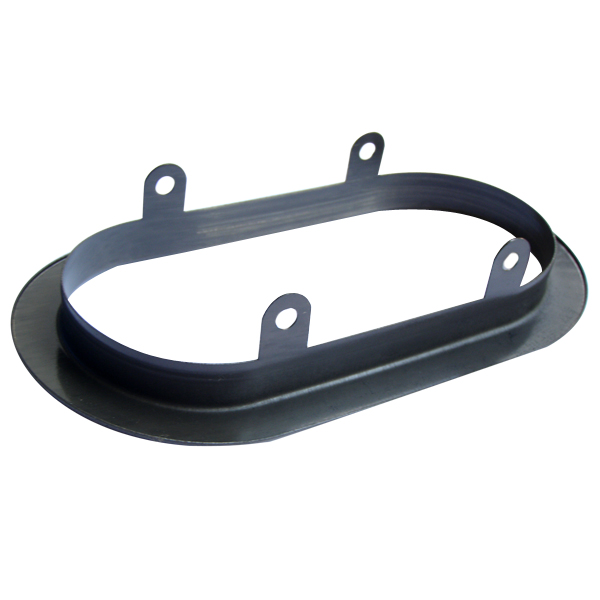
Steel is one of the most commonly used metals in metal stamping due to its versatility, strength, and affordability. It is available in various grades and can be easily formed, making it suitable for a wide range of applications across industries.
Aluminum
Aluminum is lightweight, corrosion-resistant, and has excellent conductivity. It is commonly used in industries such as automotive and aerospace, where weight reduction is crucial. Aluminum can be formed into intricate shapes and offers good strength-to-weight ratio.
Copper
Copper is highly conductive, resistant to corrosion, and offers excellent thermal properties. It is often used in electrical and electronic applications where conductivity is essential.
Brass
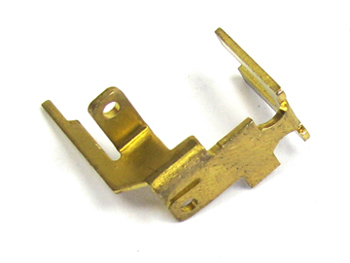
Brass is an alloy of copper and zinc, offering good corrosion resistance, machinability, and aesthetic appeal. It is commonly used in decorative applications, plumbing fixtures, and electrical connectors.
Bronze
Bronze is a versatile alloy composed mainly of copper, tin, and other elements. It offers excellent strength, wear resistance, and is commonly used in applications such as bearings, bushings, and automotive components.
Stainless Steel
Stainless steel is known for its corrosion resistance and durability. It is widely used in industries such as automotive, kitchenware, and medical equipment where hygiene and resistance to harsh environments are critical.
The selection of the metal depends on the specific requirements of the application, including mechanical properties, corrosion resistance, electrical conductivity, thermal conductivity, and aesthetic appeal. Consulting with a trusted metal stamping manufacturer, such as Chengli Hardware, can help in determining the most suitable metal for the project.
The Metal Finishing Process
The metal finishing process is a crucial step in metal stamping that enhances the appearance, durability, and performance of the stamped parts. It involves various techniques and treatments to modify the surface of the metal, providing protection against corrosion, improving aesthetics, and facilitating further assembly or integration processes.
Surface Cleaning
Before applying any finishing treatment, the stamped parts need to undergo thorough surface cleaning to remove any contaminants, oils, or debris accumulated during the stamping process. This can be achieved through cleaning methods such as solvent cleaning, aqueous cleaning, or mechanical cleaning techniques.
Deburring
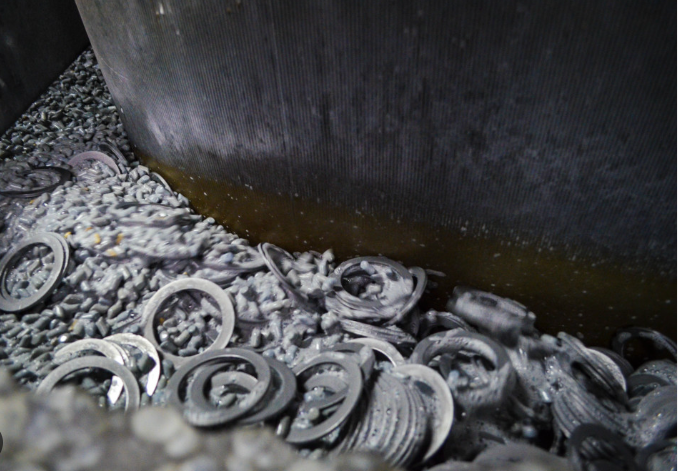
Deburring is a crucial step in the metal finishing process that involves removing sharp edges, burrs, or excess material from the stamped parts. This is typically done through mechanical methods such as tumbling, grinding, or filing. Deburring not only improves the safety of the parts but also enhances their functionality and aesthetics..
Surface Coating
Surface coating is a common metal finishing technique used to provide protection against corrosion, improve aesthetics, or enhance specific properties of the stamped parts. Some of the popular surface coating options include:
Powder Coating: Powder coating involves the application of a dry powder onto the surface of the part, which is then cured to form a durable and attractive finish. It provides excellent corrosion resistance and is available in a wide range of colors and finishes.
Plating: Plating involves the deposition of a thin layer of metal onto the surface of the part to enhance its appearance, corrosion resistance, and conductivity. Common plating options include nickel plating, chrome plating, and zinc plating.
Anodizing: Anodizing is an electrochemical process that creates a protective oxide layer on the surface of aluminum. It improves corrosion resistance, increases surface hardness, and offers options for coloring the part.
Painting: Painting is a versatile finishing option that allows for customization in terms of color, texture, and appearance. It provides protection against corrosion and adds an aesthetic appeal to the stamped parts.
Polishing and Buffing
Polishing and buffing are metal finishing techniques used to create a smooth, reflective surface on the stamped parts. These processes involve the use of abrasive materials and polishing compounds to remove imperfections, scratches, or surface irregularities, resulting in a glossy and visually appealing finish.
Marking and Etching
In some metal stamping applications, marking or etching may be required to provide identification, traceability, or decorative elements. Techniques such as laser marking, chemical etching, or mechanical engraving can be employed to achieve
Heat Treatment
Heat treatment can be applied to modify the mechanical properties of the stamped parts. This process involves controlled heating and cooling of the metal to alter its hardness, strength, or other characteristics. Heat treatment techniques include annealing, tempering, quenching, and more, depending on the specific requirements of the part.
Metal Stamping Applications
Metal stamping is a versatile manufacturing process that finds application in various industries and is utilized to produce a wide range of components. The precise nature of metal stamping, along with its ability to achieve high-volume production with consistent quality, makes it an ideal choice for many applications. Here are some areas where metal stamping is commonly applied:
Automotive Industry
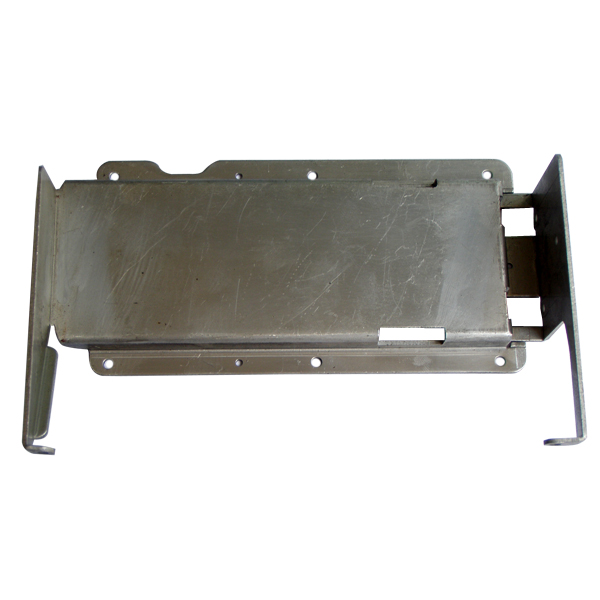
Metal stamping plays a vital role in the automotive industry, where it is used to manufacture components such as brackets, clips, chassis parts, engine parts, electrical connectors, and structural components. The ability of metal stamping to produce parts with high precision, strength, and durability makes it crucial in ensuring the safety and performance of vehicles.
Electronics and Electrical Industry
Metal stamping is widely utilized in the electronics and electrical industry to produce connectors, terminals, contacts, lead frames, and other intricate components. The process allows for the creation of precisely engineered parts that meet the demanding requirements of electronic devices and electrical systems.
Appliances and Home Goods
Metal stamping is extensively employed in the manufacturing of appliances and home goods. It is used to produce parts for refrigerators, ovens, washing machines, HVAC systems, and various household items. Metal stamping ensures the production of durable, reliable, and aesthetically pleasing components for everyday use.
Aerospace and Aviation
The aerospace and aviation industries rely on metal stamping to fabricate components with high strength, precision, and reliability. Metal stamping is used to produce parts for aircraft structures, landing gear, engine components, and interior fittings. The ability to create complex shapes with tight tolerances makes metal stamping a critical process in this sector.
Medical and Healthcare
In the medical and healthcare fields, metal stamping is employed to manufacture surgical instruments, medical devices, implantable components, and diagnostic equipment. The process ensures the production of sterile, biocompatible, and precision-engineered parts that are essential for patient care and medical procedures.
Other Industries
Metal stamping also finds applications in a wide range of other industries, including construction, energy, telecommunications, marine, and more.
Custom Metal Stamping
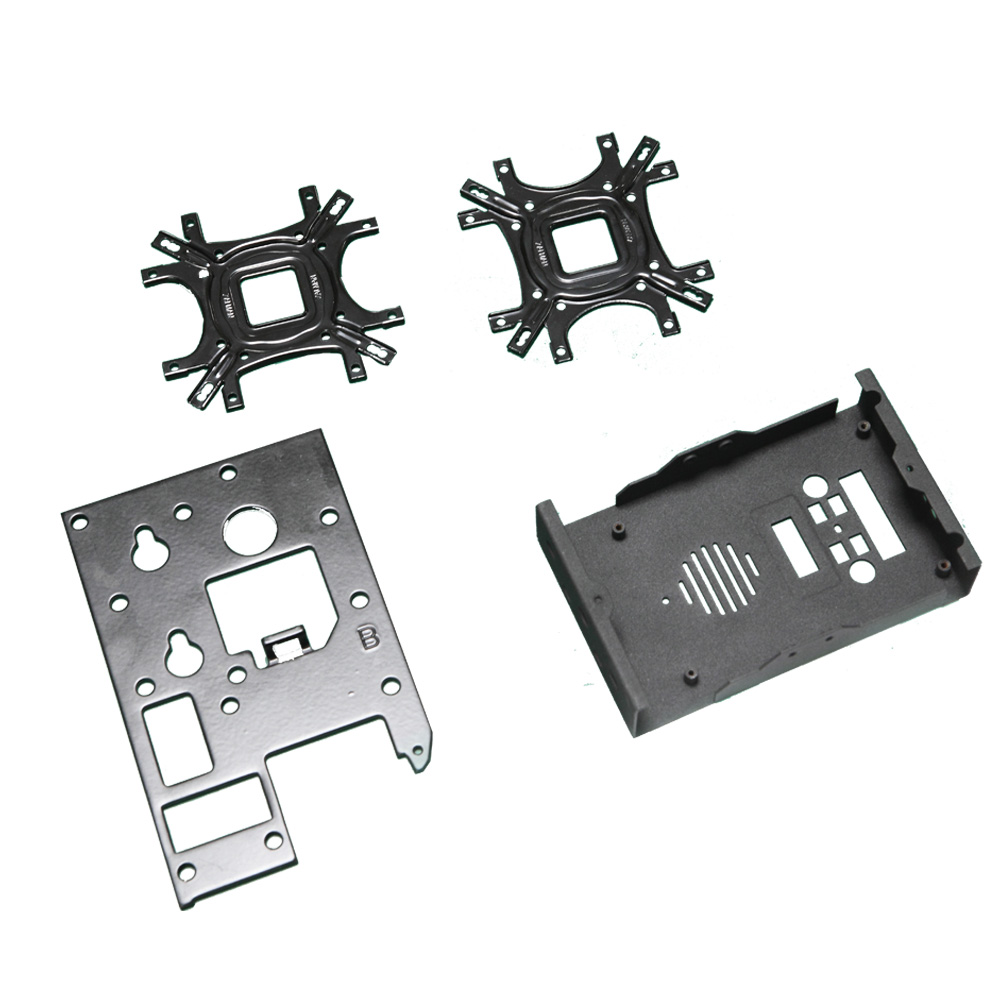
Custom metal stamping refers to the process of manufacturing metal components that are specifically tailored to meet the unique requirements of a particular application or customer. It involves the production of parts with specific shapes, sizes, tolerances, and features that are designed to fulfill the specific needs of a project or product.
Explanation of Custom Metal Stamping
Custom metal stamping goes beyond the production of standardized parts and offers the flexibility to create highly customized components. It begins with the collaboration between the customer and the metal stamping manufacturer, where the customer provides detailed specifications and requirements for the desired part.
The metal stamping manufacturer then utilizes their expertise in engineering, tooling, and manufacturing processes to design and produce the custom part. This involves the use of specialized dies and machinery to accurately shape and form the metal according to the customer’s specifications.
Custom metal stamping can involve various operations, including blanking, piercing, bending, forming, coining, and more. The process may also require secondary operations such as welding, machining, or assembly to achieve the desired final product.
Why and When You Might Need Custom Stamping
There are several situations where custom metal stamping becomes necessary and beneficial:
Unique Part Requirements: When standard off-the-shelf parts do not meet the specific requirements of a project, custom stamping allows for the creation of parts tailored to the exact specifications and design criteria.
Prototype Development: Custom stamping is commonly employed during the prototyping phase of a product. It allows for the quick production of sample parts to test and validate the design, functionality, and fitment before proceeding to mass production.
Product Differentiation: Custom metal stamping enables manufacturers to create distinctive parts that set their products apart from competitors. It provides opportunities for unique shapes, branding elements, and specialized features that enhance product performance and aesthetics.
Complex Geometries: Custom stamping is particularly valuable when dealing with intricate or complex part geometries that cannot be achieved with standard stamping processes. It allows for the precise forming and shaping of intricate features and contours.
High-Volume Production: While custom stamping is commonly associated with small production runs, it can also be applied to high-volume manufacturing. Customized dies and automation techniques can be employed to achieve efficient and cost-effective production even for large quantities.
Conclusion
Metal stamping is a versatile and efficient manufacturing process that offers precise, reliable, and cost-effective solutions for various industries. From automotive to electronics, aerospace to appliances, metal stamping plays a vital role in producing high-quality components.
Whether you require standard parts or custom solutions, partnering with a reputable metal stamping company can ensure the production of accurate and durable components that meet your specific needs. Embrace the capabilities of metal stamping and unlock the potential for innovation, quality, and efficiency in your manufacturing processes. Contact us at Chengli Hardware to discuss your metal stamping requirements today.
Frequently Asked Questions (FAQ)
Q: How do you stamp on metal?
A: Metal stamping is achieved by using a stamping press, which applies force to a metal workpiece to deform it into a desired shape. The press consists of a die and a punch that work together to create the desired impression on the metal.
Q: Which device is used for stamping metal?
A: The device commonly used for stamping metal is a stamping press. This machine applies force to shape and form metal into the desired configuration using specialized tooling, such as dies and punches.
Q: How do you stamp engrave metal?
A: Metal stamping and metal engraving are different processes. Metal stamping involves pressing a die into the metal to create a raised or recessed design, while metal engraving uses a cutting tool to remove material and create the design directly on the metal surface.
Q: Do you need a steel block for metal stamping?
A: A steel block, also known as a bolster, is often used as a base or support for the metal being stamped. It provides stability and helps distribute the force evenly during the stamping process.
Q: Is metal stamping expensive?
A: Yes,metal stamping is expensive for prototypes,low volume and short runs stamping.. While metal stamping can be cost-effective for high-volume production, it may have higher upfront costs for tooling compared to other manufacturing processes.
Q: Can I use a regular hammer for metal stamping?
A: Metal stamping typically requires specialized equipment, such as a stamping press, to apply precise and consistent force. While a regular hammer may be suitable for light or manual stamping tasks, it is not ideal for achieving the level of precision and efficiency required for most metal stamping applications.
Q: What are the four types of metal stamping?
A: The four main types of metal stamping processes are blanking, piercing, bending, and forming. These processes encompass a wide range of techniques and operations to shape metal into the desired form and configuration.
Q: What is the best metal for metal stamping?
A: Aluminum, steel and stainless steel are the best metal for stamping.
Q: What is the difference between engraving and stamping metal?
A: The main difference between engraving and stamping metal lies in the process and outcome. Engraving involves removing material to create a design, while stamping involves deforming the metal surface to create a raised or recessed impression. Engraving uses cutting tools, while stamping uses a die and punch to shape the metal.
Q: Can you use Sharpie for metal stamping?
A: While Sharpie markers can be used to temporarily mark or label metal surfaces, they are not suitable for permanent metal stamping. Metal stamping requires specialized tools and processes to create lasting impressions or markings on the metal surface.
Q: What is the best surface for metal stamping?
A: The ideal surface for metal stamping is a flat, clean, and smooth metal sheet or workpiece. It is essential to have a stable and consistent surface to achieve accurate and consistent results during the stamping process.
Q: What is the best gauge metal for stamping?
A: 24 Guage to 20 Guage. Different gaugemetals can be used for stamping, ranging from thin sheet metals to thicker gauge materials. It is important to select a gauge that provides the necessary structural integrity for the intended application while ensuring that it is compatible with the stamping process and equipment being used.
Q: What is a stamping tool called?
A: The tool used in metal stamping is called a stamping die or simply a die. A die consists of two parts: the upper component, known as the punch, and the lower component, known as the die. The die is mounted on the stamping press and provides the cavity or form into which the metal is shaped, while the punch applies the force to shape and cut the metal.
